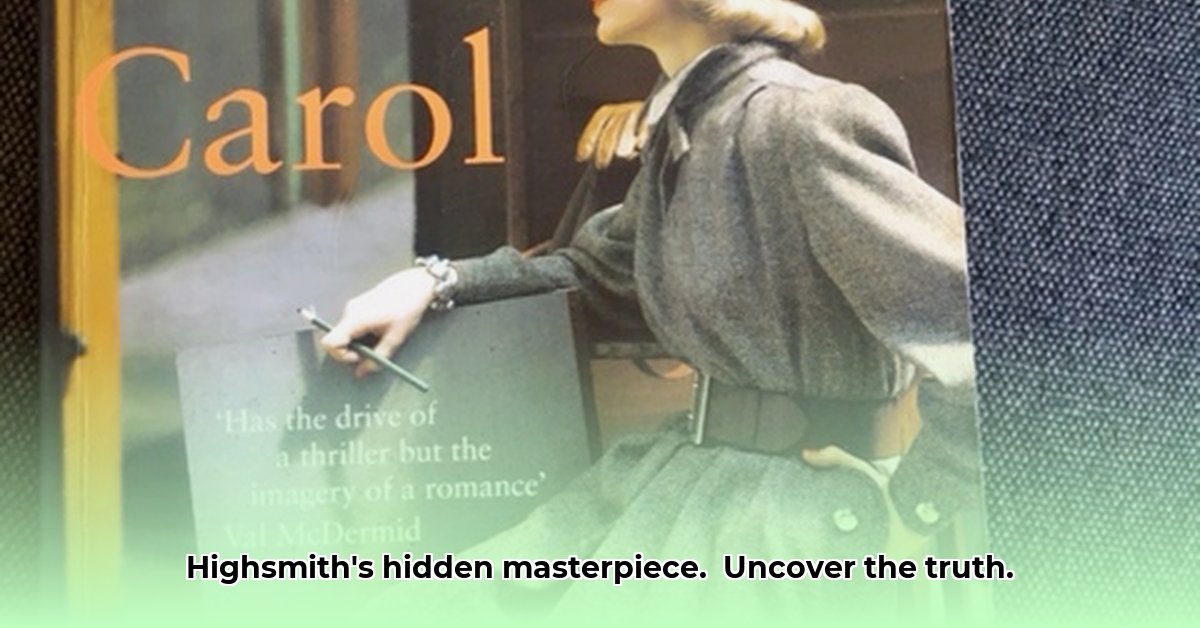Patricia Highsmith’s Carol, originally published under the pseudonym Claire Morgan as The Price of Salt, is more than a simple love story. It is a groundbreaking exploration of female desire and societal constraints in 1950s America, offering a nuanced portrayal of LGBTQ+ identity and the courage it takes to defy expectations. This essay delves into the reasons behind Carol‘s enduring appeal, analyzing the complex relationship between Therese Belivet and Carol Aird, the subtle power dynamics at play, and the impact of the restrictive social climate that shaped their choices. We will examine the novel’s key themes—love, self-discovery, and the search for authenticity—while also exploring potential connections to Highsmith’s own life and the critical debates surrounding this landmark work. For more authors exploring similar themes, check out this list of authors like Colleen Hoover.
Unveiling the Enduring Allure of Carol: A Literary Exploration
Carol transcends the boundaries of a typical romance novel. It is a profound examination of human connection, societal pressures, and the complexities of love and desire within the context of 1950s New York. Its relevance persists because it captures universal themes of longing, identity, and the courage to defy societal expectations. Published at a time when such stories were rarely told with honesty and sensitivity, Carol remains a powerful and important work of literature.
Therese and Carol: Deconstructing the Layers of a Complex Bond
At the heart of Carol lies the intricate connection between Therese Belivet, a young department store clerk yearning for something beyond her mundane existence, and Carol Aird, an elegant and sophisticated woman trapped in an unhappy marriage and facing a difficult divorce. Therese is captivated by Carol’s confidence and allure, while Carol finds in Therese a sense of genuine connection and a respite from the constraints of her life. Their relationship is a nuanced exploration of attraction, desire, and the shifting power dynamics that characterize their interactions.
The Imbalance of Power: A Source of Ongoing Critical Discussion
The inherent power imbalance within Therese and Carol’s relationship has fueled considerable critical debate. Carol’s wealth, social standing, and experience inevitably create a dynamic where she holds a certain advantage. Some critics argue that this imbalance undermines the romantic ideal, while others contend that it realistically reflects the societal inequalities and the complexities of relationships formed under such circumstances. This ongoing discussion ensures that Carol remains a compelling and thought-provoking subject of analysis.
Defying Expectations: Societal Barriers and the Valor of Desire
Highsmith’s novel bravely depicts a lesbian romance during a time of intense social stigma and legal restrictions. Forced to conceal their feelings and navigate a world that condemns their love, Therese and Carol’s relationship underscores the societal pressures and vulnerabilities faced by LGBTQ+ individuals. This courageous exploration of female desire challenged conventional norms and paved the way for greater LGBTQ+ representation in literature and culture.
Autobiographical Echoes: Tracing Highsmith’s Personal Imprints
While no explicit biographical connections can be definitively proven, scholars and readers have long speculated about the potential influence of Highsmith’s personal experiences on Carol. Her own struggles with identity, her complex relationships, and her observations of societal hypocrisy may have subtly shaped the narrative. This interplay between reality and fiction adds another layer of intrigue, prompting readers to consider the possible links between the author’s life and her fictional creation.
Critical Acclaim and Continuing Dialogue: A Catalyst for Conversation
Carol has received widespread praise for its pioneering portrayal of lesbian love, its compelling characters, and its evocative prose. However, critical opinions vary, with some focusing on the psychological depth of the characters, while others analyze the novel’s social commentary. These diverse perspectives contribute to the book’s enduring merit, demonstrating its remarkable ability to elicit strong reactions and spark meaningful discussions.
The Enduring Legacy of Carol: A Testament to Timeless Themes
Carol endures as a powerful exploration of human connection, societal constraints, and the pursuit of authenticity in a world that often demands conformity. It challenges readers to confront uncomfortable truths about prejudice, power, and the complexities of love. The novel’s lasting legacy, along with its successful adaptations for film and theater, affirms its profound impact on literature, culture, and our understanding of the human heart.
Deconstructing Power Dynamics in Patricia Highsmith’s Carol
Highsmith’s Carol is a masterful study of power, demanding that we carefully examine the ever-shifting dynamics between Therese and Carol and how these forces influence their choices and shape their destinies.
Key Considerations:
- Highsmith intricately portrays the multifaceted power dynamic between Therese and Carol.
- A thorough analysis necessitates examining their desires, societal constraints, and the ebb and flow of control.
- The novel’s intentional ambiguity invites diverse interpretations and fuels ongoing debate.
Deciphering Subtleties: The Power Play Between Therese and Carol
More than a simple love story, Highsmith’s Carol dissects the intricate negotiations of desire, influence, and control that define human relationships. From their initial encounter to their cross-country journey, Therese and Carol engage in a subtle dance of power, where each character seeks to assert their agency and navigate the complexities of their connection.
Societal Constraints and Subverted Expectations: Power Dynamics in the 1950s
The rigid societal expectations of the 1950s exert a significant influence on Therese and Carol’s power dynamic. Carol’s marital status, wealth, and experience grant her a certain degree of social power, while Therese’s youth and relative freedom present her with a different kind of agency. Their attempts to subvert these expectations further complicate their relationship and highlight the challenges they face in a world that seeks to define their roles.
A Multifaceted Approach: Dissecting the Narrative of Power
To fully analyze the power dynamics in Patricia Highsmith’s Carol, we must consider these key facets:
- Individual Motivations: What are each character’s underlying desires, fears, and vulnerabilities? How do these motivations influence their actions and decisions?
- Subtle Actions and Gestures: Who initiates contact? Who sets the tone of their interactions? What subtle cues reveal their power dynamics?
- Financial Power: How does Carol’s financial independence impact their choices? Does it create a sense of obligation or dependence?
- Emotional Manipulation: To what extent do they use emotional manipulation to gain control or influence? How do they navigate the complexities of emotional vulnerability?
- Cultural Context: How do the societal constraints of the 1950s shape their perceptions of power and influence?
Interpretation and Legacy: A Timeless Debate on the Novel’s Meaning
Highsmith intentionally creates ambiguity and leaves many questions unanswered, making Carol endlessly fascinating and open to interpretation. The novel invites ongoing discussion and reinterpretation.
Carol’s Deconstruction of 1950s Societal Restrictions on Female Identity and Desire
Patricia Highsmith’s The Price of Salt (later republished as Carol) and Todd Haynes’ acclaimed film adaptation offer distinct yet complementary perspectives on the restrictive societal climate that shaped the lives of LGBTQ+ individuals in the 1950s.
Key Insights:
- Both the novel and film offer unique insights into the complexities of the central relationship.
- Both powerfully illustrate the challenges and sacrifices faced by Carol and Therese.
- Carol’s most enduring strength lies in its portrayal of the constraints placed on female identity and desire.
Therese and Carol’s Confined World: Dissecting the Impact of Social Norms
Highsmith’s novel and Haynes’ film vividly illustrate how the social norms of the 1950s directly impacted the lives of Therese and Carol. Open expressions of same-sex love were not only taboo but also carried significant legal and social consequences. The characters are forced to navigate a world that actively seeks to suppress their desires and punish any deviation from established norms.
The Burden of Expectations: The Challenges They Confront
The 1950s imposed a rigid social order, with clearly defined roles for men and women. Carol, already facing the stigma of divorce and a custody battle, confronts even greater challenges as a woman involved in a same-sex relationship. Therese, too, must grapple with societal expectations as she is drawn into a forbidden love that threatens to disrupt her life and future.
Contrasting Adaptations: Novel vs. Film
While both versions explore the theme of societal repression, the novel delves deeper into the emotional and psychological complexities of the characters, their internal struggles. Carol’s most profound impact lies in its authentic and nuanced portrayal of the restrictions imposed on both women.
Legacy: A Story That Echoes Across Generations
Despite being set decades ago, Carol remains relevant and resonant because it explores universal themes of love, identity, and the courage to defy societal expectations. Carol’s legacy lies in its exploration of societal constraints, continues to inspire conversations.
Exploring Autobiographical Influences Shaping Carol’s Narrative
Key Considerations:
- Carol‘s enduring appeal stems from its sophisticated portrayal of female desire.
- The novel and its film adaptation offer distinct stylistic choices and narrative approaches.
- The hidden depths of Highsmith’s autobiographical influences shaping Carol’s narrative are significant.
Delving into Therese and Carol: A Compelling Character Study
Patricia Highsmith’s Carol is a psychological portrait. Carol’s character may be inspired by a blonde woman in a mink coat Highsmith once encountered.
Societal Constraints and the Weight of Secrecy
The novel depicts societal repression through subtle gestures, coded
- Major Lyric Contest Opens Doors for Aspiring Songwriters - December 14, 2025
- American Song Contest 2025 Invites Songwriters To Impress Industry Experts - December 13, 2025
- Song Contest USA Faces Challenges To Find National Success - December 12, 2025










